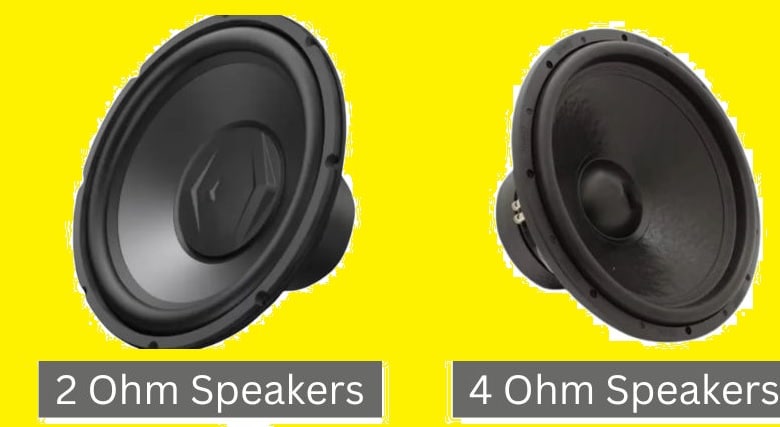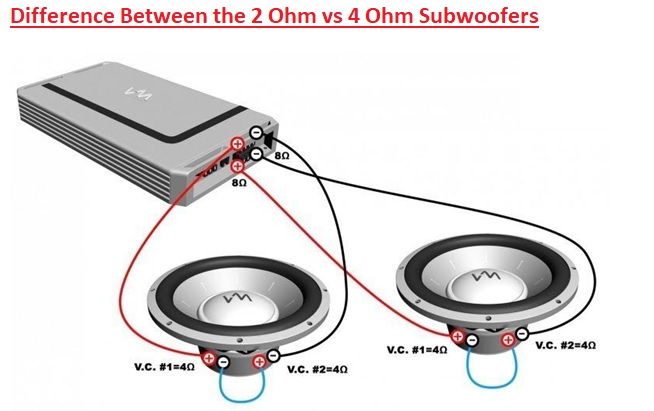Hello readers, welcome to the new post. Here we will discuss 2 Ohm Vs 4 Ohm Subwoofer | What’s The Difference? Which To Buy 2023. The 2-ohm subwoofers come with less resistance are louder have sacrificed sound quality and use high power. The 4 Ohm subwoofers provdies clear sound high efficiency and good durability. This post will discuss the main differences between 2 Ohm and 4 Ohm subwoofers. So let’s get started 2 Ohm Vs 4 Ohm Subwoofer.
2 Ohm Subwoofers: Pros and Cons
The 2-ohm subwoofers come with less value of resistance. it is a louder sound as it can use more power from the amplifier. There are some disadvantages of 2 Ohm subwoofers. But high power use sound quality is not better than 4 ohm subwoofer
Pros
- It produces loud sound
- it has less resistance which helps to get high power from the amplifier.
Cons
- its sound quality is not good.
- High power resulted the high losses.
- It can distort at high volumes.
4 Ohm Subwoofers: Pros and Cons
The high resistance it has. That helps to use less power and generates good and unmistakable sound.
Pros:
- It uses less power and saves energy
- it has a sharper and clearer sound
- its sound does not distort high volumes
- It is more robust thatn 2 home speakers
Cons:
- Its sound is less loud than 2 ohm subwoofer
Similarities Between 2 Ohm vs. 4 Ohm Subwoofers
- They can provide good-sounding bass based on the audio system
- Their cost is the same
- They can buy in different sizes and designs.
- Both needed amplifiers for proper working
2 ohm vs 4 ohm subwoofer
| 2 Ohm Subwoofer | 4 Ohm Subwoofer |
|---|---|
| Louder Sound | Quieter Sound |
| Prone to Distortion at Loud Volumes | No distortion at Loud Volumes |
| Less Durable | Durable |
| connected to an amplifier or stereo with a 2 Ohm less impedance | Can connect to a 2 Ohm or 4 Ohm stereo/amp |
Differences Between 2 Ohm vs. 4 Ohm Subwoofers
- The 2-ohm subwoofers can provide louder sound with poor sound
- 2 ohm subwoofer can distort if used for high volumes.
- both needed to be paired with a supported external amplifier or stereo.
- The 4 Ohm subwoofers are energy efficient.
- The 4 Ohm subwoofers can work longer.
2 ohm vs 4 ohm speakers
- The 2-ohm speaker comes with less resistance and high power from the amplifier flow in the speaker. So they can produce high sound.
- The 4-ohm speaker comes with high resistance or higher impedance, so it uses less power from the amp normally causing the quiet output. High resistance can provide clear, well-defined sounds, especially for complex audio mixes.
What’s better, a 2ohm or 4ohm subwoofer?
- The 2-ohm subwoofer is louder but it is it prone to distortion than the 4ohm
- 4 OHm subwoofer comes with a deep base effect. It generated a clean sound that was not distorted. But it is comparable to 2 ohme.
- If there is a need for louder sound use a 2-ohm subwoofer. For clear and deeper bass without any distortion 4 home subwoofer is the best option.
- To save energy use 4 ohms which uses less electricity. While 2ohm uses more electricity for the generation of louder sound and increases bills.
- 4 Ohm subwoofer works for a longer duration than 2 Ohm modules.
- 2 ohm subwoofers are higher cost than 4 ohms. But you can use it according to your requirements and budget.
- These two models come in different shapes and sizes!
How To Test 2 Ohm vs 4 Ohm Subwoofer
if there is a need to know which subwoofer your system has, either 2 or 4ohm, test with the use of a multimeter tha has an ohmmeter. The process is simple and explained here
- Ensure the subwoofer is not connected to the amplifier or any power supply
- Remove the subwoofer from the casing
- Connect multimer probes with the cover coil terminal of the woofer. The probes are red and black, so they connect in the same colors.
- Set meter value at read resistance in ohms. If the meter comes with a limit, set it to 200 ohms.
- See reading on a screen that is 2 or 4 in homes
1-Ohm Car Subwoofers
The 1 home subwoofer is made for maximum power and volume. It has features to handle high power and generate loud and high-power bass sounds. Since they have low impedance and need certain amplifiers that can provide high current.
With that 1 1-ohm subwoofer is less effective than other impedance levels, which means needs more power to generate the same volume than a 2-ohm or 4-ohm subwoofer.
What Happens when you Replace a 2 Ohm Speaker with a 4 Ohm?
We can replace a 2-ohm speaker with 4 ohm if the amp and wiring help. The result is an improvement in sound quality and effective power use
Can I Connect a 2 Ohm Subwoofer to a 4 Ohm Amplifier?
No, it can be dangerous and damage the subwoofer. We should connect 2 ohm woofers with amplifiers with less impedance of 2 ohms.
What Hits Harder, 2 Ohm or 4 Ohm?
The 2 homes subwoofer can provide high loud sound but 4ohm has clear sound and low-end response. They can hit hard but operation is based on the system
Is 4ohm or 2ohm better for subs?
If you need the most power for the amplifier use 2 ohm sub. it increases amplifier rating power that is 500 watts rms at 2ohms. The 4 ohms subwoofer is not getting high curent tha has less power output from amplifiers.
What ohm is best for sound quality?
4 Ohm speakers are high quality but can be paired with an amplifier that handles increased sound and volume. It is used in headphones and desktop computer speakers.
What ohm is best for bass?
What is the advantage of a 4 ohm speaker?
How many ohms is a bass speaker?
Faqs
-
How much louder is 2 ohm than 4 ohm?
- The 2 Ohm subwoofer is louder but prone to distortion. While a 4 Ohm subwoofer comes with a deeper bass effect. It produces clear sound that does not distort
-
What ohm is best for sound quality?
- Normally 2, 4, and 8-ohm speakers are used. If resistance is high sound will be good, and cleaner. But 4 ohms is common.
- The high resistance causes less power, and lower home more power
-
Can I run 2 ohms to a 4 ohm speaker?
- Yes, it will work since it is ohm speaker that comes with a double resistance of 2 ohm. So it will have half power output.
-
How many watts is 2 ohms?
- For 2 ohm speaker, the maximum output power is 550 watts.
-
Which is louder 1 ohm or 2 ohms?
- The one home will get more power output from the amplifier and subwoofers will play a loud sound if connected with 2 ohm load. There is no substitute for power for maximum volume and one ohm, amplfier put out more power
-
How many volts is 2 ohms?
-
Ohm Volt/ampere [V/A] 0.01 ohm 0.01 V/A 0.1 ohm 0.1 V/A 1 ohm 1 V/A 2 ohm 2 V/A
-
-
Is a higher ohm speaker louder?
- For louder without creating distortion, there is a need to find speakers with higher impedance ratings than those with lower ratings.
-
Is 1 ohm equal to volts?
- One ohm is equal to 1 volt / 1 ampere. SI unit of electrical resistance ohm
-
Which is louder, 4ohm or 8ohm?
- The 4 ohm speaker comes with a higher power handling feature than the 8-ohm speaker. if used in conjunction with accurate amplifiers, comes with features to generate high sound volumes with less distortion
-
Do ohms affect voltage?
- Ohm’s law states that current is directly proportional to voltage and inverse to resistance. The voltage curent and resistance in formula form is I = V/R, I is the current (A), V is the voltage in volts (V), and R is resistance in ohms ( Ω ).
-
How do I calculate ohms?
- According to Ohms law R = V/I. formula used for measuring the ohm value
-
Which ohm is best for bass?
- If there is a need for louder sound use 2 ohm subwoofer. If needed clear and deep bass without any sound distortion use 4 ohm subwoofer. For low power use then use 4 Ohm models. it uses less power.
-
Are 2 ohm speakers louder than 4 ohm?
- The 2-ohm speaker comes with low resistance, so has high power from the amplifier speaker and can produce louder sound
-
Do 4 ohm speakers sound better?
- The 4-ohm speaker comes with higher power handling features than the 8 ohm speaker. If used in conjunction with an accurate amplifier, comes with features to generate high sound volumes with less distortion
-
Can 4 ohm subs run at 2 ohms?
- The DVC 4 ohm sub can be connected with the system as 2 ohms or as 8 ohm load. The DVC 2 ohm sub can come with an impedance of 1 ohm or 4 ohms.
-
Do ohms affect sound quality?
- Ohm is important for finding both volume and sound quality, but they use for passive speakers, that can draw power from an external amp
-
How to tell if a sub is 2ohm or 4ohm?
- Subwoofer voice coils are in 2-ohm, 4-ohm, or 8-ohm impedances. The value can be found on the magnet, If not sure about that
-
Which speaker is better, 2 ohm or 4 ohm?
- The standard 4 ohm is not a bad speaker, the required for 2 ohm system helps high power to flow from the head unit or amplifier. it means good volume, and good quality, which is needed for car audio.







